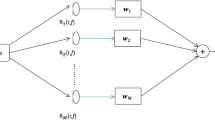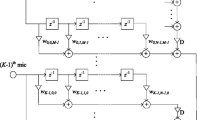Abstract
The design problem of broadband beamformers is to choose the coefficients of the filters such that the difference between the actual spatial directivity pattern and a desired spatial directivity pattern is minimized. There are many factors which can influence the performance of the design. The prominent factors include the filter length and the number of microphones. In the literature, the condition in fitting a desired spatial directivity pattern totally has not been studied properly. We show here that it is essential to use both the filter length and the number of sensors in reducing the cost function to zero, subject to some conditions on the desired response. These conditions are investigated and developed. Numerical examples are used to verify the derived conditions and at the same time to present some optimal beamformer designs.










Similar content being viewed by others
References
Liu, W., Weiss, S.: Design of frequency invariant beamformers for broadband arrays. IEEE Trans. Signal Process. 56(2), 855–860 (2008)
Ng, B.P., Duan, H.P.: Designing amplitude/phase response of the frost beamformer. IEEE Trans. Signal Process. 55(5), 1944–1949 (2007)
Gannot, S., Burshtein, D., Weinstein, E.: Signal enhancement using beamforming and nonstationarity with applications to speech. IEEE Trans. Signal Process. 49(8), 1614–1626 (2001)
Sawada, H., Araki, S., Mukai, R., Makino, S.: Blind extraction of dominant target sources using ica and time–frequency masking. IEEE Trans. Audio Speech Lang. Process. 14(6), 2165–2173 (2006)
Chan, S.C., Chen, H.H.: Uniform concentric circular arrays with frequency-invariant characteristics: theory, design, adaptive beamforming and DOA estimation. IEEE Trans. Signal Process. 55(1), 165–177 (2007)
Feng, Z.G., Yiu, K.F.C., Nordholm, S.: A two-stage method for the design of near-field broadband beamformer. IEEE Trans. Signal Process. 59, 3647–3656 (2011)
Feng, Z.G., Yiu, K.F.C., Nordholm, S.: Placement design of microphone arrays in near-field broadband beamformers. IEEE Trans. Signal Process. 60(3), 1195–1204 (2012)
Lau, B.K., Leung, Y.H., Teo, K.L., Sreeram, V.: Minimax filters for microphone arrays. IEEE Trans. Circuits Syst. II 46(2), 1522–1525 (1999)
Yiu, K.F.C., Yang, X.Q., Nordholm, S., Teo, K.L.: Near-field broadband beamformer design via multidimensional semi-infinite linear programming techniques. IEEE Trans. Speech Audio Process. 11(6), 725–732 (2003)
Dolco, S., Moonen, M.: Design of far-field and near-field broadband beamformers using eigenfilters. Signal Process. 83, 2641–2673 (2003)
Kennedy, R., Ward, D., Abhayapala, T.: Nearfield beamforming using radial reciprocity. IEEE Trans. Signal Process. 47, 33–40 (1999)
Nordholm, S., Claesson, I., Dahl, M.: Adaptive microphone array employing calibration signals: an analytical evaluation. IEEE Trans. Speech Audio Process. 7, 241–252 (1999)
Yiu, K.F.C., Grbic, N., Teo, K.L., Nordholm, S.: A new design method for broadband microphone arrays for speech input in automobiles. IEEE Signal Process. Lett. 9(7), 222–224 (2002)
Acknowledgments
This paper is supported by the RGC Grant PolyU. (5301/12E). The first author is also supported by the Grant of Chongqing Science and Technology Commission (No. cstc2013jcyjA1407) and the Program of Chongqing Innovation Team Project in University under Grant (No. KJTD201308).
Author information
Authors and Affiliations
Corresponding author
Additional information
Communicated by Mark J. Balas.
Appendix
Appendix
1.1 Proof of Lemma 3.1
Proof
Since the basis \( \{1, \cos k\omega ,\sin k\omega ,\;\; k=1,\ldots ,\infty \}\) are orthogonal and complete in \([-\pi ,\pi ]\), and \(u(\omega )\) and \(v(\omega )\) are periodic, continuous, absolute integrable, and both right-hand and left-hand derivatives exist, then, their Fourier series are given by
Define \(x_{k}\) by
Then, we have
This completes the proof. \(\square \)
1.2 Proof of Lemma 4.1
Proof
Since the basis \( \{1, \cos k\omega ,\sin k\omega ,\;\; k=1,\ldots ,\infty \}\) are orthogonal and complete in \([-\pi ,\pi ]\), and \(u(\omega )\) and \(v(\omega )\) are periodic, continuous, absolute integrable, and both right-hand and left-hand derivatives exist, then, their Fourier series are given by
Define \(x_{k}\) and \(y_{k}\) by
Then, we have
This completes the proof. \(\square \)
1.3 Proof of Theorem 4.1
Proof
For any \(f\in [0,f_\mathrm{{s}}/2]\), take a transform \(\varphi =\nu (f)\phi \). Denote \(\mathcal {A}^{0}_{k}(f,\phi )\) and \(R(f,\phi )\) by \(\bar{\mathcal {A}}_{k}(f,\varphi )\) and \(\bar{R}(f,\varphi )\), respectively, with \(\phi \) being replaced by \(\varphi \). Then, it follows from (24) that \(\bar{\mathcal {A}}_{k}(f,\varphi )\) is given by
Then, \(\bar{\mathcal {A}}_{k}(f,\varphi )\in \left\{ e^{-j2\pi k\varphi }, k=-\infty ,\ldots ,+\infty \right\} \).
For the definition of \(\bar{R}(f,\varphi )\), note that the transform \(\phi \rightarrow \varphi \) is a bijection and maps \([-1,1]\) to \([-\nu (f),\nu (f)]\subset [-1/2,1/2]\), if \(f>0\). We define \(\bar{R}(f,\varphi )=R(f,\phi /\nu (f))\), \(\forall \varphi \in [-\nu (f),\nu (f)]\). If \(f=0\), then \(\nu (f)=0\) and the transform \(\phi \rightarrow \varphi \) maps \([-1,1]\) to a point \(0\). Note that \(R(0,\phi )\) is a real constant number, and then define \(\bar{R}(0,0)=R(0,0)\). Hence, \(\bar{R}(f,\varphi )\) is well defined.
The definition domain of \(\bar{\mathcal {A}}_{k}(f,\varphi )\) and \(\bar{R}(f,\varphi )\) is \(\Omega =\{(f,\varphi ):f\in [0,f_\mathrm{{s}}/2],\varphi \in [-\nu (f),\nu (f)]\}\). Since the real part and the imaginary part of \(R(f,\phi )\) are continuous, absolute integrable, and both right-hand and left-hand derivatives exist in \([0,f_\mathrm{{s}}/2]\times [-1,1]\), then the real part and the imaginary part of \(\bar{R}(f,\varphi )\) are also continuous, absolute integrable, and both right-hand and left-hand derivatives exist in \(\Omega \).
Then, the problem (30) is equivalent to find a sequence of complex functions \(\{\mathcal {X}^{0}_{k}(f)\in \Gamma _{0},k=-\infty ,\ldots ,+\infty \}\), such that
To prove (b), we extend the definition of \(\bar{R}(f,\varphi )\) from \(\Omega \) to \([0,f_\mathrm{{s}}/2]\times \mathbb {R}\). The extended definition of \(\bar{G}_\mathrm{{d}}(f,\varphi ,\eta ,\bar{\eta })\) should keep some conditions:
-
(i)
\(\bar{R}(0,\varphi )\) are real constant numbers.
-
(ii)
The real part and the imaginary part of \(\bar{R}(f_\mathrm{{s}}/2,\varphi )\) are even and odd, respectively.
-
(iii)
For each \(f\in [0,f_\mathrm{{s}}/2]\), \(\bar{R}(f,\varphi )\) is periodic with period \(1\).
-
(iv)
The real part and the imaginary part of \(\bar{R}(f,\varphi )\) are continuous, absolute integrable, and both right-hand and left-hand derivatives exist.
It remains to extend the definition domain from \(\Omega \) to \([0,f_\mathrm{{s}}/2]\times [-1/2,1/2]\) with the terminal condition \(\bar{R}(f,-1/2)=\bar{R}(f,1/2)\). Then, the function will be periodic with period \(1\).
Note that if \(r=c/f_\mathrm{{s}}\), \(\nu (f_\mathrm{{s}}/2)=1\). It is not necessary to extend the definition of \(\bar{R}(f,\varphi )\) when \(f=f_\mathrm{{s}}/2\), since \(\bar{R}(f_\mathrm{{s}}/2,x)=R(f_\mathrm{{s}}/2,x/2)\), \(\forall x\in [-1,1]\). It follows from the conditions (A2)–(A4) in Theorem 4.1 that the conditions (ii)–(iv) are satisfied in the case of \(f=f_\mathrm{{s}}/2\).
There are many kinds of methods for the extension. A simple method is the linear interpolation. For each \(f\in [0,f_\mathrm{{s}}/2]\), we extend the definition of \(\bar{R}(f,\varphi )\) as
Then, by this interpolation, it can be verified directly that the conditions (i)-(iv) are satisfied.
By Lemma (4.1), for each \(f\in [0,f_\mathrm{{s}}/2]\), there exists a sequence of \(\{\mathcal {X}^{0}_{k}(f)=x_{k}(f)+jy_{k}(f):k=-\infty ,\ldots ,+\infty \}\) such that the equality (b) holds in \([0,f_\mathrm{{s}}/2]\times [-1/2,1/2]\). Hence, it also holds in the subset \(\Omega \).
It remains to verify that \(\mathcal {X}^{0}_{k}(f)\in \Gamma _{0}\), \(\forall k=-\infty ,\ldots ,+\infty \). Since the coefficients exist, they can be computed directly by
Then, we verify that \(\mathcal {X}^{0}_{k}(f)\in \Gamma _{0}\). From (i), \(\bar{R}(0,\varphi )\) is a real constant number. Suppose that the constant is denoted by \(\alpha \). Then, we have
Hence, \(\mathcal {X}^{0}_{k}(0)\) is a real number.
From (ii), the real part and the imaginary part of \(\bar{R}(f_\mathrm{{s}}/2,\varphi )\) are even and odd, respectively. Suppose that the real part and the imaginary part of \(\bar{R}(f_\mathrm{{s}}/2,\varphi )\) are denoted by \(\alpha (\varphi )\) and \(\beta (\varphi )\). Then, we have
The imaginary part of (e) is computed by
Hence, \(\mathcal {X}^{0}_{k}(f_\mathrm{{s}}/2)\) is a real number.
Since both the real part and the imaginary part of \(\bar{R}(f,\varphi )\) are continuous, absolute integrable, and their right-hand and left-hand derivatives exist, if follows from the equation (d) that the real part and the imaginary part of \(\mathcal {X}^{0}_{k}(f)\) are continuous, absolute integrable, and their right-hand and left-hand derivatives exist.
Thus, the function \(\mathcal {X}^{0}_{k}(f_\mathrm{{s}}/2)\), which is given in (d), belonging to \(\Gamma _{0}\). Then, equation (30) is true. This completes the proof. \(\square \)
Rights and permissions
About this article
Cite this article
Feng, Z.G., Yiu, K.F.C. & Nordholm, S.E. Performance Limit of Broadband Beamformer Designs in Space and Frequency. J Optim Theory Appl 164, 316–341 (2015). https://doi.org/10.1007/s10957-014-0543-5
Received:
Accepted:
Published:
Issue Date:
DOI: https://doi.org/10.1007/s10957-014-0543-5




